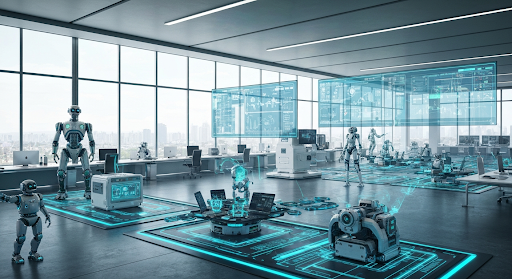What Is HMI IN PLC
Hello everyone, today we are going to learn all the basics of Hardware Management Interfaces. They likely sound a little bit unfamiliar, but you’ve most likely come across them plenty of times.
The HMI is an interface that you see very often in industry. It can control and monitor the machine, and it might be present on any machine or ATM you use on a regular basis. Many Human Machine Interfaces, or HMI screens for short, are designed to look like computer monitors in order to make them more intuitive for the user. The majority of these screens are touchscreens, meaning that they can be interacted with via finger gestures and movements; this is a helpful feature as it can reduce the amount of time spent navigating complex menus.
A machine operator or maintenance personnel oversees the HMI, in order to operate and monitor machines.
AI can help automatically include a lot of information like temperature, pressure, the steps to process and how much material was used. The change in location also makes it easier to read the meters from afar and prevent accidents together with other factors.
For technicians, an HMI can also show a plant's PLC logic on the screen. This saves time compared to connecting a computer every time; as most people would need a computer or laptop to go through this process.
The use of HMI devices can also help automate certain processes as they provide direct access to monitored equipment. This means that an entire complex could be controlled through a centralized screen, which could save the business a lot of time and money.
This can be done using HMI software with a PLC. You can track remote locations or equipment in your plant remotely and in real-time.
You should know how an HMI SCADA can help you better control machinery. They're like a control panel which enables you to monitor and send instructions through a connection between the machine and the HMI.
Special Software
First, HMIs use software specialized for engineers who program them with their own code. Some HMI panels use a different software depending on their brand so it makes sense to investigate further before you buy the right model.
The software allows engineers to design an interface that operators will actually see. They can monitor important aspects on the screen, and use buttons to work with the machine.
Examples of HMI
For example, a human machine interface could have a large tank on the screen displaying the level of an object inside to the user. There is also screenspace for displaying information about pumps and valves that can be used to manipulate the liquid level.
An HMI might also have a start/stop button displayed on the screen next to the pump. When you touch it, the button would be able to transfer that input into an action and turn that exact pump on or off.
But, it's actually not that simple to set up. The person programming the HMI needs to have a thorough knowledge of how to connect the components - buttons and indicators on screen - with corresponding inputs or outputs on a PLC.
So Whats’ The Point
This also brings up another point: the HMI and PLC need to be compatible with each other. Without being able to “talk” to each other, it becomes a lot harder for them to do their job. You can find compatible devices by looking at the device's protocol.
There are many different industrial protocols out there. For example, Modbus, Ethernet/IP, and Profibus. All of these protocols serve the same basic function- they're just industrial networks on a larger scale."¦if you think about your own home network with multiple devices instead of computers that communicate together, they're the same idea.
Once the PLC and the HMI are connected, it's possible to control PLC activities using input from the HMI.
In Review
This article teaches you some of the basics about HMI and interface design. HMI is the interface that allows machine operators and monitor to better operate their machinery.
Engineers can program HMIs to do almost anything that a PLC can. They work together which is why they're compatible, and because they're so tightly coupled, if one of them isn't functioning properly, it'll affect the other.



